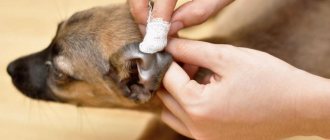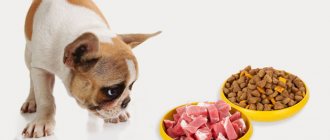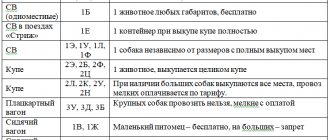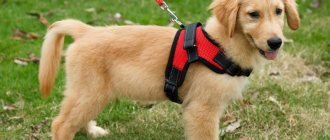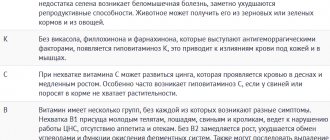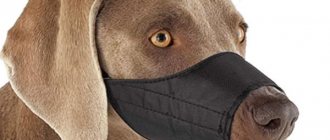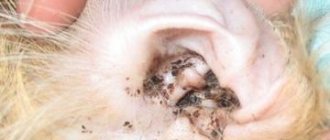Hearing plays a leading role in a dog’s full life—their sensitivity is legendary. And it is the owner’s responsibility to take care of the pet’s hearing organs.
Photo: dktrpepr
Regular examination of the ears will help to avoid diseases, prevent the development of infections and the proliferation of mites. In this case, it is important to correctly assess the type of ears - erect, cropped, hanging.
Puppies of some breeds have their ears glued with adhesive tape to obtain the correct set (Yorkies, Dobermans) - such cases require a special approach.
If necessary?
Is it necessary and is it even possible to clean dogs’ ears? Of course yes! Wax accumulates in a dog's ears, and if you don't take care of them, then dirt also accumulates, which the animal is not able to clean out on its own.
It is necessary to clean your ears from time to time - this will protect against infections, fungus, inflammatory processes in the ears, diseases associated with the ears (for example, otitis media), as well as the proliferation of mites, which love to settle in delicate places.
In addition, the condition of your pet’s ears can be used to track a number of diseases in the early stages. If the ear turns red, the skin becomes irritated, swollen, and more wax is produced than usual, then this is a sign that it is time to visit the veterinarian.
Disgusting odor from dog's ears: quick cure strategy
Is it possible to clean with chlorhexidine?
Chlorhexidine is an antiseptic, colorless or yellowish, almost odorless. A 5% solution is used to clean the ears.
Be sure to consult your veterinarian before using this product. The solution may cause allergies.
Chlorhexidine should be used with caution; it is not compatible with soap and sodium lauryl sulfate.
Be careful when bathing your pet. Make sure that soap or shampoo does not get into the dog's ears because... Chlorhexidine is not compatible with soap and sodium lauryl sulfate. If detergent does get into your ears, you should rinse them thoroughly with warm water.
How often?
How often you should clean your ears is not a simple question and there is no clear answer. The time between ear cleanings varies for different breeds. There are dogs that need to have their ears cleaned daily, while for others it is a rare, more preventative procedure. As in any matter, you need to know when to stop: if you clean an animal’s ears too often, you can destroy the natural protective microflora, and this is fraught with disease. The dog needs sebum and even a little sulfur to protect it from the outside world: temperature changes, dust.
How often you need to clean your ears will depend on:
- Ear lengths and shapes. The short standing ears are well ventilated and there is little dirt in them. But long, hanging ears, for example, like those of a basset hound, are not only a source of pride for the owner, but also an excellent “dust and dirt collector.” They sweat faster and dirt, sebum and wax quickly accumulate in them. Mites also often live on long ears.
- Wool lengths. The longer it is, the more frequent and thorough ear care is needed. Some, for example, a Yorkshire Terrier or a Chinese Crested, will also have to pluck the hairs in their ears - they will fall off in the ear canal and interfere with hearing and normal ventilation. This procedure is painless, but a little ticklish.
- How often does the dog go out for walks ? There is no place for your pet's ears to get especially dirty, and you can limit yourself to cleaning as natural contamination occurs - once a week or two.
- The age of the dog. The older the pet, the more careful and regular care it requires. How often should you clean your puppy’s ears? In fact, a puppy under 1 year of age may not need serious cleaning at all, but they need to be taught a list of grooming procedures. Even without direct need, you need to arrange regular procedures with your baby: run a comb over the body, touch the teeth, belly, examine the ears, claws.
So that your ears don't get dirty!
Every day you need to examine your pet's ears, regardless of breed. The auricle should be pink, warm and clean. The presence of an unpleasant odor or a squelching sound should alert you: this indicates an infection in the ear canal. In this case, it is better not to clean it yourself, but to contact a veterinarian.
The pet itself will indicate problems: it will begin to scratch its ear more often, and will squeal when trying to touch it. But it’s not worth starting before that.
Tip : to understand whether it’s time to clean your ears, carry out a simple test. You need to moisten a cotton swab in water and gently rub the ear canal. A gray or yellowish coating formed on the stick indicates that so far everything is in order. But if a piece of sulfur comes out along with the stick, it’s time to carry out the procedure.
Do dogs need to have their ears cleaned and why?
A four-legged pet receives almost a third of information about the outside world through the organs of hearing. Sounds are the most important part of an animal’s life; it is guided by them in most cases.
The dog's ears regularly become dirty: dust and dirt, water get into them, and insects fly in. Contamination of the ear canal in an animal is fraught with the appearance of serious diseases. This is why maintaining dog ear hygiene is extremely important.
Regular cleaning of the external auditory canal will help prevent not only the development of infectious diseases, but will also prevent serious inflammatory processes. The examination allows you to timely identify possible pathological conditions in the ear canal:
- tumors;
- hematomas;
- redness;
- increased release of sulfur;
- presence of an unpleasant odor.
Ear hygiene is one of the necessities along with brushing teeth, trimming nails and trimming fur. Ear cleaning at home should be done regularly throughout the animal's life.
Cleaning products
How and what products can you clean your dog's ears with? One cotton swab is not enough to clean a dog’s ears; it must be moistened with something. What exactly depends on the condition of the animal. Warm water is enough for regular care, but don’t forget about modern products. They have a complex effect: they destroy bacteria, remove unpleasant odors and facilitate the cleaning procedure.
Lotions
A special cleansing lotion is an ideal product for monthly preventative cleaning. It cannot be used more often: lotions kill both harmful and beneficial bacteria, which makes the animal’s ears vulnerable to infections.
The benefit of lotions is that they contain special agents that dissolve dirt and sulfur. It’s enough to drop a couple of drops, lightly massage your ear, and all dirt will be shaken off.
You need to buy such a product at a veterinary pharmacy, having previously inquired about the manufacturer and composition. You may be allergic to low-quality cheap lotions.
It may contain:
- boric acid (for disinfection and softening of sulfur),
- salicylic acid (anti-inflammatory),
- malic acid (dissolves sulfur),
- oils (eucalyptus, tea tree), which disinfect and soften the skin,
- chamomile extract and aloe vera (regenerating agent).
Important : if it contains alcohol, you should not buy lotion.
There are dozens of lotions for cleaning dogs' ears. The most popular, but also the most expensive product is Otifree , made in France. You will need to pay almost 800 rubles for a bottle. Hartz (USA, 330 rubles) , Mr. Bruno (Russia-Switzerland, 150 rubles) and the budget Russian product Bars (100 rubles).
Hydrogen peroxide
Is it possible to clean your ears with something from a human pharmacy - hydrogen peroxide, for example? Cleaning dog ears with 3% hydrogen peroxide, iodine, cologne, vinegar or even vodka belongs to the category of dubious folk recommendations that it is better not to practice on your animal.
Of course, the product will disinfect the ear, but if you make a slight mistake with the dosage, cleaning with peroxide can cause severe burns . In addition, there will be nothing left of beneficial bacteria, and the skin will dry out.
So cleaning your ear with hydrogen peroxide is a bad and dangerous idea!
For comparison: any of the lotions, which are recommended to be used no more than once a month, have a more gentle composition. If there is nothing else at hand, it is better to rinse the auricle with ordinary warm water.
Chlorhexidine
Is it possible to clean ears with chlorhexidine? This solution is suitable for cleaning ears because... it is an excellent antiseptic and disinfectant, suitable for both people and animals. For your dog, you need to choose a chlorhexidine solution that says “For external use.” But this is a medicine that is not used just like that - only for inflammation, uncomplicated otitis, after consulting with a veterinarian.
You can also rinse the ears with a chlorhexidine solution for an adult animal that has been taken from the street. It is important to know that chlorhexidine does not tolerate the presence of anionic groups, soap, or alkalis, since in their presence it is inactivated. This means that you should not wash your ears with shampoo or anything else before using chlorhexidine.
Ear drops
A product that is similar in effect to lotions. In addition to the disinfectant, ear cleaning drops have an antipruritic and therapeutic effect; if there are wounds in the ears, they promote rapid healing.
There is a whole line of drops that fight ticks and heal scratched areas ( Aurican, Dekta, Otovedin, Otoferonol Premium ). The compositions of drops and lotions are very similar. Popular drops – Bio-Groom (USA, 1000 rubles), Bars (Russia, 100 rubles).
The drug costs 1000 rubles. contains boric acid, salicylic acid and eucalyptus oil. And although the drops are a medicinal drug that should be selected under the guidance of a veterinarian, and they cannot be used constantly, we advise you not to waste money and choose these drops. To some extent, the exception is the drug " Rosinka ", developed on the basis of herbs - St. John's wort, calendula and sage. It perfectly cleanses the ear canal, removes inflammation and swelling.
Before using the drops, you need to clear your ears of wax for the product to work. Putting drops into dirty ears is even harmful - the bacteria will gradually get used to the active substance, and it will be more difficult to remove them. You cannot drip cold drops, this will make the animal dizzy. First, warm them in your hands.
Gel
This product has a disinfectant effect, thicker than lotion. Gels appeared on the market not so long ago, and have not yet gained popularity among dog lovers. As a rule, the composition of the drug, created on the basis of water, contains herbal extracts, chlorhexidine, propolis. A definite plus is the absence of alcohol among the ingredients used.
If you choose between gel and lotion as a liquid for cleaning your ears, then it is better to choose the first one. It has fewer contraindications, the gel can be used more often, plus allergies rarely occur to it.
Artero gel based on tea tree oil is popular (Spain, 600 rubles).
Spray
It differs from gels and lotions mainly in the way it is used: it is sprayed rather than dripped into the dog's ear. On the one hand, it is easier, on the other hand, many animals are scared by the sound of the sprayer.
Sprays can be used once a week, which is also an advantage over lotions. You can start getting acquainted with sprays with the drug Auricap (Ukraine, 150 rubles), made on the basis of basil oil.
Powder
The powder is used to quickly clean the ears of healthy dogs. Great for long-eared breeds. It can also be a lifesaver if your pet is actively opposed to cleaning with a cotton swab.
It is enough to pour the powder inside the ear, holding the bottle at a distance of 2.5 cm from the auricle, wait a little and shake it off. Performs bactericidal and anti-inflammatory functions, dries out secretions and removes unpleasant odors.
There are powders that remove ear hairs - but you will need to rub them in with a cotton swab. You can use the powder once a week, but if it was prescribed by a veterinarian as a remedy, then every day.
When buying powder, you need to pay attention to the presence of iodoform - an antiseptic, it should be there. Bio-Groom Ear-Fresh (USA, 750 rubles), Espree EAR POWDER (USA, 750 rubles) have proven themselves well
Symptoms of an ear infection in a puppy
Before discussing the symptoms of ear infections, let's discuss what are the different types of ear infections?
There are mainly three types of ear infections. These are external, middle and internal otitis, affecting different parts of the dog's ear. According to a survey conducted in 2022, it was found that about 20% of pet puppies suffer from some form of ear infection. So it's our job to find out if our puppy is suffering from this painful infection.
Now let's discuss the types of ear infections and their symptoms.:
- Otitis externa is a term used to describe an infection in which the lining of the cells or external auditory canal becomes inflamed.
- Otitis media and internal otitis is an infection of the middle and internal auditory canal. The problem of ear infection is not limited to just pain and irritation. However, in some cases the infection has progressed to its most severe forms, causing facial paralysis, deafness, or signs of vestibular disease. So if you see your dog circling, tilting his head and becoming uncoordinated, this is a clear sign that your dog needs immediate attention, take him to the vet.
Now that we have discussed infections, let's discuss the symptoms in detail:
- The puppy shakes his head.
- Unpleasant odor and odors.
- The skin becomes scaly.
- A smelly discharge that is often dark in color.
- The puppy begins to whine and put a plug in the ear affected by the infection.
- Swelling of the ear.
- Redness may be seen in the affected ear.
- Itching.
- Lack of balance.
- Unusual eye movement.
- The puppy begins to tilt its head.
- May also cause hearing loss.
If you notice any of the above symptoms, you should consult your veterinarian as soon as possible.
© shutterstock
How?
- A cotton swab is the most common option.
The stick is soaked in a special lotion; it can also be used to rub powder and rub in drops. But for beginners, this is not the best option, because a stick can easily damage the animal’s delicate ear. Important : do not be afraid to rupture the eardrum: a dog’s ear is designed in such a way that it cannot be reached. - A cotton ball, dry or wet, works great for gentle ear care. It should be placed in the ear and gently rolled, cleaning all corners. The most important thing is to remember that the ball will still need to be taken out.
- A cotton pad is another alternative to a ball; there is not much difference between them. They can be used to gently remove dirt from inside the ear. But it will be difficult to manipulate a cotton pad on an irritable animal, because it is a slow process.
- Sanitary wipes for dog ears . This miracle remedy can be purchased at any veterinary pharmacy. They are already impregnated with a special composition that will dissolve dirt and sulfur. The wipes are great for emergency cleaning of the ears, for example, before a show, to give your pet a thorough cleaning. You can use them regularly, but it is much more expensive than a cotton ball.
What is the best way to clean the ears of a particular dog is difficult to say without trying. Most likely, it will be easier with a cotton ball or napkin, but it all depends on the character of the pet and the condition of the ears. Sometimes you will need the entire arsenal.
Step-by-step instruction
Before you start cleaning your ears, think through your actions and prepare everything you need. Decide where you will do it. Lay out so that they are at hand, but will not fly apart due to your or your dog’s awkward movement:
- lotion or decoction or solution
- cotton pads, or sticks, or gauze
- napkins
- if necessary - special oil or medicine, or powder
- treat for encouragement
Ear cleaning is not only a hygienic procedure, but also an indicator of a trusting relationship with your pet. If your pet trusts you, he will willingly leave his ears at your complete disposal. Therefore, the owner should try to do everything in a calm, friendly atmosphere, without intimidating.
The dog must be in a good mood - after eating, immediately after washing, cleaning can be combined with other procedures (for example, grooming). For the first time, you may need an assistant.
Photo: dohlongma
Here are some ways to clean your ears.
Method 1
- Fix the dog, pet it, or put it on its side. Raise hanging ears.
- Examine the ears to determine the degree of contamination
- Place lotion or decoction in ears
- Gently massage the ear without causing discomfort or pain.
- Remove dirt and excess liquid with a cotton swab or dry soft cloth
- Wipe the inside of your ears. The dog can shake out the “byaka” himself by shaking his head, there is no need to prohibit it
- Praise, give a treat
Veterinarian cleaning dog's ears (video)
Method 2
- Put some drops in your ear
- Stroke, massage gently
- Use a damp cotton swab to clean areas of anatomical bends
- Twist a thin tourniquet from gauze, place it in your ear and gently roll it to the side and outward several times.
Method 3
- Pour liquid to dissolve dirt and wax into the ear until it flows out a little
- Massage the lower part of the ear and the ear fold (30 seconds is enough). You will hear a slurping sound
- Carefully wipe off the liquefied dirt with sulfur with a napkin - there will be a brown coating on the napkin
- If there is a lot of liquid dirt, repeat steps 1,2,3
- If after repeating there is still too much dirt, you can postpone the procedure and repeat it in a few days. The solution remaining in the ear is harmless and does not need to be washed off
- If during the repeated procedure there is a lot of sulfur, or the dog yelps when touched, contact your veterinarian, it may be an ear infection
Method 4
- Use a cotton ball. Saturate it with ear cleaner until moisture oozes out.
- Place the ball in your ear and massage for about 30 seconds. During this time, the dirt and sulfur will dissolve, and the dog will enjoy it
- Take out the cotton wool and wipe your ear
- If necessary, repeat steps 1,2,3
Method 5 (for large dogs)
For large dogs, it is inconvenient to use cotton swabs and pads. Therefore, you can simply wrap your finger in gauze, dip it in the solution and clean your ear. Make sure there are no threads left in it
Ear after cleaning. Photo: louisbath
If dried wax crusts remain in the ears, they are dissolved with special oil and removed after soaking. But you shouldn’t overuse the oil; stuck together hairs not only deprive the ear of its natural protection, but can also cause blockage of the ear canal.
What should you absolutely not do?
“Do no harm” - this rule of doctors is also effective for dogs. We have already discussed above why you should not clean your dog’s ears with alcohol-containing solutions and hydrogen peroxide. Children's lotions and soaps, although seemingly harmless, are not suitable for animals - they can cause allergies. You should also be wary of recommendations to rinse your ears with herbal tinctures without consulting a veterinarian.
To clean your ears, you should not take objects not intended for this purpose - wooden or plastic sticks, or gauze. During the cleaning process, the latter will leave strings that are difficult to remove from the ear. It is strictly forbidden to use matches and toothpicks - if the dog twitches even a little, the ear will be seriously injured.
What not to use
The following remedies can leave a burn, injury, and irritate the thin epidermis in a dog’s ear:
- ethyl, food and boric alcohol;
- gel, shampoo, soap, etc.;
- vinegar essence;
- oil extracts.
Expert opinion
Anna Abramenko
An avid dog lover. Experience in veterinary medicine since 2009.
Ask a Question
The dog's ears should be carefully inspected and cleaned carefully. This is a sensitive organ that reacts with inflammation to various violations of hygiene.
How to do it right at home
Everything is prepared, it’s time to move on to the cleaning procedure. To do this you need:
- Choose a good time - when the animal is fed and calm. It is good if the procedure occurs immediately after washing the dog. There is no point in catching an excited dog around the house and restraining it by force - this can scare it, and later the procedure will be more difficult. So, if something goes wrong, it is better to temporarily abandon the cleaning procedure and return to it later.
- Secure the animal. First you need to command “Lie down”, then pet the dog, carefully lay it on its side. If the ear hangs, it is carefully lifted.
- Conduct an external inspection. If there is dried dirt, you should put drops or lotion in to soften it and wait a couple of minutes. You should not release the animal for this time - it will be more difficult to secure it a second time. It’s better to pet the dog and talk to it.
- When the dirt has partially dissolved, moisten a stick or cotton ball in lotion or warm water and thoroughly clean the ear. Do not rush or push the cleanser too deeply into the ear.
- Perform an ear massage - rub the cleaned ear with gentle movements. This will dissolve the remaining dirt, plus the dog will be pleased. She will be more relaxed about the procedure.
- Remove remaining sulfur and dirt. After a massage with a dry cotton swab, small particles of sulfur are removed and the ear canal is dried.
- If necessary, trim or pluck ear hairs.
- Praise the animal and release it with the command “Walk!” and watch him for a while. If it shakes its head, it’s okay, this is how the dog gets rid of the remaining lotion in his ears. By the way, if the dog wants to shake his head while cleaning, don’t bother him either.
The green area can be cleaned. You can't go into the red!
Advice : if the ears are long and very dirty, it is better to clean them one at a time, with breaks, maybe even at intervals of a day, otherwise it will be difficult for the dog to withstand.
It is important to remember that cleaning ears even at home is a kind of stress for your pet. You need to talk to him all the time, stroke him, maybe pat him on the back. It often takes four hands to thoroughly clean the ears (especially of long-eared breeds). In this case, it is worth calling someone from your family whom the dog knows and trusts, just like the owner. Otherwise, the pet will perceive this as “two for one”, and may harbor a grudge.
It is not worth holding the dog by force during cleaning - unless his life depends on ear procedures.
Frequency
The frequency of ear cleaning in different types of dogs depends on a large number of factors, among which a special place is given to the age of the pet and the structure of the hearing aid. Healthy puppies and young individuals undergo hygiene at intervals of 2-3 months. But this is an average value. To determine the need for the procedure, the following nuances must be taken into account:
- presence of heavy contamination;
- restless behavior, shaking the head, scratching the ears with paws;
- formation of scratches and wounds on the inner surface;
- accumulation of black plaque with a specific odor.
In these cases, it is recommended to carry out hygiene with chlorhexidine or miramistin. If after a short period of time wax or plaque has formed again, it is recommended to show the dog to a veterinarian.
If it doesn't
What should you do if your dog categorically refuses to allow you to clean your ears? In theory, everything sounds good, but in practice, your pet may flatly refuse to clean its ears.
- Don't try to clean your ear right away . Let the pet first learn to trust its owner. To do this, you need to call him to you more often and, while maintaining eye contact, touch his ears and stroke them. Gradually, you can pay more and more attention to the ears: touch, massage, lift. Some stubborn breeds, such as terriers, will take a long time to get used to, but it will happen.
- You shouldn't have your ears cleaned at a veterinary clinic for the first time. Dogs remember negative emotions for a long time – and a visit to the veterinarian is usually one of them. In the future, it will be more difficult to persuade the animal.
- Never scold your dog for misbehaving during ear cleaning. There is no need to aggravate already bad feelings.
- When restraining the animal, do not squeeze it too hard - it will get scared and begin to instinctively try to free itself.
- Don't skimp on treats after the procedure. Before you start cleaning, you can show the animal a tidbit and let him know that he will soon get it (but this method will not work with impatient puppies; it is better to feed them constantly).
- Before purchasing a new ear cleaner, smell it. A sharp, unusual smell can scare even a quiet pet.
- If you can’t come to an agreement with your pet, you should put on a muzzle to protect your fingers.
Helpful Tips:
- You can shorten the cleaning procedure for dogs with long ears by not using cotton pads, but simply wrapping a damp cloth or napkin around your finger.
- The ears of small breed dogs cannot be cleaned from the inside with cotton swabs: the narrow ear canal will not be cleaned this way. But the opposite effect - thickening of earwax - is possible. The outside of such ears is cleaned with cotton wool, and the inside is washed with a syringe.
How to get your dog used to ear cleaning
Some animals actively resist attempts to carry out hygiene procedures. This usually happens because the owner doesn’t clean the ears properly or doesn’t pay enough attention to raising the dog. You need to teach your dog to clean his ears from an early age.
The pet must get used to the fact that the owner carries out various manipulations with its limbs, teeth and ears. At the initial stage of training, you can simply touch the animal’s ears and massage them. It is extremely important to maintain the dog's trust and not cause him any discomfort. When the animal gets used to you, you can carefully begin the procedure of cleaning the ear canal.
Representatives of some breeds (for example, terriers) are extremely stubborn and do not allow their ears to be cleaned. The owner must show persistence and patience. He must, with the help of affection and food reinforcement, convince the animal of the need for hygiene procedures. Screaming and violent actions when communicating with an animal are not allowed.
You can also read our article: “How to wash a dog’s eyes at home”, how to properly care for your pet’s eyes, rinsing and hygiene products.
If he shakes his head after
- If the dog intensively shakes its head, scratches its ears on different surfaces (carpet, sofa upholstery, etc.), it means that something has gone wrong. It is likely that, due to your enthusiasm, when cleaning your ears, you got too deep into your ear and injured the ear canal. Often people do not clean out the sulfur, but compact it.
If after cleaning your dog shakes his head for a long time and diligently, then drop 2 drops of liquid, non-flavored and non-essential oil (olive, sunflower) into each ear and massage directly along with the ear canal (along the outside of the ear down and up).Do not stop the dog from shaking his ears, this will make his fate easier. If the injury is severe, then you need to buy ear drops that contain lidocaine or novocaine. They have a calming effect (this is a mild anesthesia).
- Nothing is injured, the dog just starts shaking his head to expel the solution from the ear canal.
- If dogs shake their heads after sleep, then most likely it’s just time to clean their ears!
Which dog breeds require more frequent ear care?
The breeds most susceptible to ear infections are lop-eared dogs, such as dachshunds, spaniels, basset hounds, beagles, and some varieties of poodles. The ears of such animals are not ventilated, and dirt accumulates, especially if long or curly hair is present. This can cause the proliferation of pathogenic bacteria and fungi.
Reference! If your pet has long hair and floppy ears, ask a groomer to trim the hairs around the ears or do it yourself periodically.
Regular ear hygiene in these breeds is the key to your pet’s health and well-being. Supplement your care with a special powder - it will remove excess sweat and moisture from the skin folds of the ears.
Regularly monitor the condition of your pet’s ears and promptly remove dirt - this will help avoid the development of inflammatory diseases and improve your pet’s well-being . Opt for grooming products designed specifically for dog ears, as they can liquefy earwax without irritating the skin.
Puppy
Until three months, the puppy is looked after by its mother, and it does not need hygiene procedures. But in order to avoid problems in the future, the baby needs to be taught a set of hygiene procedures: examining the ears, eyes, teeth, even if there is no need for this yet. The puppy must get used to the fact that the owner’s hands bring him only pleasure and benefit.
Starting from six months, you can start cleaning with a cotton ball. The procedure is no different from cleaning an adult dog. But it's best to do this in a game format.
Some breeds need thorough ear cleaning from childhood:
- York . How to properly clean a Yorkie puppy's ears? The ears of this breed require special attention because hair grows inside them. The puppy is taught to brush, apply lotion, remove hairs with tweezers and powder. This will need to be done every 2 weeks. Yorkies are smart and, having understood what the owner wants, will not become capricious. The main thing is not to scare.
- Labrador . How to clean a Labrador puppy's ears? The Labrador has delicate and rather large ears, and a rather stubborn character. That is why this breed begins to be trained from childhood. When cleaning the Labrador's ears, you need to be very persistent so that the dog understands that the time of hygiene procedures is determined by the owner. If the puppy struggles strongly, you should wrap it in a diaper (paws), but do not scream or hit.
- Spaniel . How to clean a spaniel puppy's ears? The beautiful ears of a spaniel are a source of problems for the owner. This is exactly the breed that really needs to have its ears cleaned almost from birth, because a small spaniel will collect all the dirt with its ears. The procedure is carried out as usual, plus it is worth plucking the hair on the inside of the ears if there is excess of it there.
What should you do to clean your puppy's ears?
Before describing and proceeding, please note that a puppy's ear is not like ours. Dogs' ears are much more sensitive and therefore, when trying to help your pet recover from the disease, take your time, I suggest you be careful as any wrong move can cause serious damage. Also note that your puppy will not want to clean his ears, so you will need to work with him.
It is important to achieve maximum results - we mean that we need the right tools.
What you can do is prepare a bag with a cotton swab or tap your finger on the gauze and use it, you may want to use a pair of gloves but if you don't have any then you can just do it without gloves. Finish work and wash your hands afterwards. Perhaps one of the most important tools you can use is to rinse your puppy's ears. Just do your research when looking for an ear rinse for your pup and make sure that it does not contain any steroids, alcohol, and is not intended to be toxic.
Don't miss it all. What we want to say is keep everything handy and don't run for tools or related items while cleaning as this will make cleaning difficult and may also damage your puppy's ears.
